Simeon Saxe-Coburg-Gotha
Simeon Borisov von Saxe-Coburg-Gotha[1] (Bulgarian: Симеон Борисов Сакскобургготски, Simeon Borisov Sakskoburggotski; born 16 June 1937), known formerly or by courtesy as King Simeon II or Tsar Simeon II (Bulgarian: Цар Симеон II), is a Bulgarian politician, who had served as the last reigning Tsar of Bulgaria from 1943 to 1946, before later serving as Prime Minister of Bulgaria from 2001 to 2005.
Simeon II | |||||
|---|---|---|---|---|---|
 | |||||
| 48th Prime Minister of Bulgaria | |||||
| In office 24 July 2001 – 17 August 2005 | |||||
| President | Petar Stoyanov Georgi Parvanov | ||||
| Deputy | Nikolay Vasilev Lydia Shuleva (2001–2005) Kostadin Paskalev (2001–2002) Plamen Panayotov (2003–2005) | ||||
| Preceded by | Ivan Kostov | ||||
| Succeeded by | Sergei Stanishev | ||||
| Personal details | |||||
| Born | 16 June 1937 Sofia, Kingdom of Bulgaria | ||||
| Political party | Independent (2009–present) | ||||
| Other political affiliations | National Movement for Stability and Progress (2001–2009) | ||||
| Spouse(s) | |||||
| Children | Kardam, Prince of Turnovo Kyril, Prince of Preslav Kubrat, Prince of Panagyurishte Konstantin-Assen, Prince of Vidin Princess Kalina, Countess of Murany | ||||
| Parents | Boris III of Bulgaria Giovanna of Italy | ||||
| Alma mater | Valley Forge Military Academy and College | ||||
| Tsar of Bulgaria | |||||
| Reign | 28 August 1943 – 15 September 1946 | ||||
| Predecessor | Boris III | ||||
| Successor | Monarchy abolished Vasil Kolarov (as Acting President) | ||||
| Regent | See list
| ||||
| Premiers | See list
| ||||
| |||||
| House | Saxe-Coburg and Gotha-Koháry | ||||
| Religion | Bulgarian Orthodoxy | ||||
| Signature |  | ||||
| Bulgarian royal family |
|---|
 Coat of arms of the Kingdom of Bulgaria |
|
Simeon Saxe-Coburg-Gotha
Princess Marie Louise of Bulgaria |
During his reign as Simeon II, Tsar of Bulgaria, he was a minor, with royal authority being exercised over the tsardom on his behalf by a regency led by Simeon's uncle Prince Kiril, General Nikola Mihov and the prime minister, Bogdan Filov. In 1946 the monarchy was abolished as a consequence of a referendum, and Simeon was forced into exile in Spain. He returned to his home country in 1996, formed the political party National Movement for Stability and Progress (NMSP) and was elected Prime Minister of the Republic of Bulgaria from July 2001 until August 2005.[2] In the next elections, as a leader of NMSP, he took part in a coalition government with the ex-communist party BSP. In 2009, after NMSP failed to win any seats in Parliament, he left politics.
Simeon is one of the two remaining living heads of state from the time of World War II (the other is Tenzin Gyatso, 14th Dalai Lama of Tibet), the only living person who has borne the title "Tsar", and one of only two former monarchs in history to have become head of government through democratic elections (the other is the now-deceased Norodom Sihanouk of Cambodia).[3]
Royal history
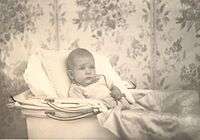
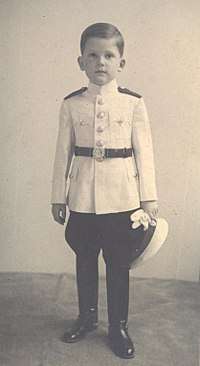
Simeon was born to Boris III and Giovanna of Italy. Following his birth, Boris III sent an air force officer to the Jordan River to obtain water for Simeon's baptism in the Orthodox faith.[4] He acceded to the throne on 28 August 1943 upon the death of his father, who had just returned to Bulgaria from a meeting with Adolf Hitler.[5][6] Since Tsar Simeon was only six years old when he ascended the throne, his uncle Prince Kyril, Prime Minister Bogdan Filov, and Lt. General Nikola Mikhov of the Bulgarian Army were appointed regents.[7]
Under his father, Bulgaria had reluctantly joined the Axis powers in World War II but had managed to preserve diplomatic relations with the Soviet Union. Still, on 5 September 1944 Stalin declared war on Bulgaria and three days later, the Red Army entered the country without encountering resistance. On the next day, 9 September 1944, Prince Kyril and the other regents were deposed by a Soviet-backed coup and arrested. The three regents, all members of the last three governments, Parliament deputies, heads of the army and eminent journalists were executed by the Communists in February 1945.[7]
Towards exile
The royal family—Queen Giovanna, Simeon II, and his sister Maria-Louisa—remained at Vrana Palace near Sofia, while three new regents were appointed (Todor Pavlov, Venelin Ganev and Tsvetko Boboshevski). On 15 September 1946, a referendum was held in the presence of the Soviet army. It resulted in a 97% approval for republic and abolition of the monarchy, and the boy-king Simeon was deposed.
On 16 September 1946, the royal family was exiled from Bulgaria. The royal family first went to Alexandria, Egypt, where Queen Giovanna's father Vittorio Emanuele III, the former king of Italy, lived in exile. There, Simeon II finished Victoria College (along with Crown Prince Leka of Albania). In July 1951, General Franco's dictatorship in Spain granted asylum to the family.[8]
Education and business career
In Madrid, Simeon studied at the Lycée Français, but did not graduate. On 16 June 1955, upon turning 18, in accordance with the Tarnovo Constitution Simeon II read his proclamation to the Bulgarian people as the Tsar of Bulgaria, confirming his will to be king of all Bulgarians and follow the principles of the Tarnovo Constitution and free Bulgaria. In 1958, he enrolled at Valley Forge Military Academy and College in the United States, where he was known as "Cadet Rylski No. 6883",[7] and graduated as a second lieutenant. Once again in Spain (between 1959 and 1962), Simeon studied law and business administration.[9]
He became a businessman. For thirteen years, he was chairman of the Spanish subsidiary of Thomson, a French defence and electronics group. He was also an adviser in the banking, hotel, electronics, and catering sectors.
Monarch in exile
Simeon issued several political declarations during his exile through his "chancellery" in Madrid directed at the Communist regime in Bulgaria and his exiled compatriots. His early attempts at forming an official government in exile did not come to fruition, however.
Marriage and issue
On 21 January 1962, Simeon married a Spanish aristocrat, Doña Margarita Gómez-Acebo y Cejuela. The couple have had five children – four sons (Kardam, Kiril, Kubrat and Konstantin) and a daughter, Kalina, all of whom subsequently married Spaniards.[7] All of his sons received names of Bulgarian kings, his daughter has a Bulgarian name, although only three of his eleven grandchildren have Bulgarian names (Boris, Sofia and Simeon).
- Kardam (1962 – 7 April 2015) married Miriam Ungría y López. They had two sons, Boris and Beltran.
- Kiril (born 1964) married María del Rosario Nadal y Fuster de Puigdórfila. They have two daughters, Mafalda and Olimpia, and one son, Tassilo.
- Kubrat (born 1965) married Carla María de la Soledad Royo-Villanova y Urrestarazu. They have three sons: Mirko, Lukás and Tirso.
- Konstantin-Assen (born 1967) married María García de la Rasilla y Gortázar. They have twins, Umberto and Sofia.
- Kalina (born 1972) married Antonio José "Kitín" Muñoz y Valcárcel. They have one son, Simeon Hassan Muñoz.
Political return
In 1990, just months after the fall of communism, Simeon was issued a new Bulgarian passport. In 1996, fifty years after the abolition of the monarchy, Simeon returned to Bulgaria and was met in many places by crowds cheering: "We want our King!"[10] He did not, at that point, make any political announcements or moves. However, these monarchist sentiments gradually disappeared after his premiership and specifically during his coalition as a leader of NMSP with the ex-Communist Party, together with changing of generations; since by that time the majority of voters were born after the fall of the monarchy.
Various estates in Bulgaria that had been nationalised during the Communist era were returned to Simeon and his family. In 2001, Simeon, who had by this time taken the name Simeon Borisov Saxe-Coburg-Gotha, announced he would return to Bulgaria to form a new political party, the National Movement Simeon II (NMSII) (later renamed to NMSP), dedicated to "reforms and political integrity."[11] Simeon promised that in 800 days the Bulgarian people would feel tangible positive effects of his government and would enjoy significantly higher standards of living.[12]
Prime Minister
- For details on his cabinet, see: Sakskoburggotski Government
NMSP won a large victory in the parliamentary elections held on 17 June 2001, capturing 120 of the 240 seats in Parliament and defeating the two main pre-existing political parties. Simeon gave an oath as Prime Minister of Bulgaria on 24 July, forming a coalition with the ethnic Turkish party, Movement for Rights and Freedoms (MRF). He gave ministerial positions in his government mainly to technocrats and Western-educated economic specialists.
During his time in power, Bulgaria joined NATO. In 2002, he received the Path to Peace Award from the Path to Peace Foundation.[13]
In the 2005 elections, Simeon's party ranked second and participated in the grand coalition government led by the Bulgarian Socialist Party and including the Movement for Rights and Freedoms. Simeon II was given the unofficial ceremonial post of Chairman of the Coalition Council.[11]
The party got just 3.01% of votes and no seats at the parliamentary elections of 2009. Shortly after, on 6 July, Simeon also resigned as NMSP leader.[14]
Views on restoration of the Bulgarian monarchy
Simeon II has never formally renounced his claim to the Bulgarian throne. He left Bulgaria without signing a formal instrument of abdication. However, since he was a minor at the time, his legal capacity to sign such a document would have been questionable at best. He used the title "Tsar of the Bulgarians" in his political statements during his exile. Since his return to Bulgaria, however, Simeon has consistently declined to reveal his views on the restoration of the Bulgarian monarchy, notwithstanding the original name of his party.[15] His triumph in the 2001 elections raised the question of a possible restoration, especially with the economic crisis, poverty, and law and order issues the country faced after the fall of communism.[16] Upon taking office as prime minister, he took an oath to protect the country's republican constitution.[17]
Simeon II criticised the Bulgarian government in 2018 after he was told to return his palace taken in 1946. The decision came at a time with rising support for a restoration of the monarchy.[18]
Autobiography
Simeon II wrote an autobiography in French under the title Simeon II de Bulgarie, un destin singulier that was released in Bulgaria on 28 October 2014.[19] It was first presented at the headquarters of the UNESCO in Paris on 22 October 2014.[20][21]
Heir to the House of Saxe-Coburg and Gotha-Koháry

After the death of his distant cousin Prince Johannes Heinrich of Saxe-Coburg and Gotha in April 2010 and due to the exclusion of the late prince's uncle Philipp and his descendants from his morganatic marriage with Sarah Aurelia Halasz, Simeon became the Head of the House of Saxe-Coburg and Gotha-Koháry, former magnates of Hungary and heir to the castles of Čabraď and Sv. Anton, both in modern-day Slovakia. In early 2012, he nominally ceded his rights (and those of his children) to the headship of the House and the title "Princess of Koháry" to his sister Marie Louise.
Longevity
Simeon turned 80 years old on 16 June 2017, at which time Ferdinand I held the record for the longest-lived head of state in Bulgarian history, having been 87 years, and 197 days old when he died, on 10 September 1948.
Titles, styles, honours and awards
| Styles of Simeon II of the Bulgarians | |
|---|---|
 | |
| Reference style | His Majesty |
| Spoken style | Your Majesty |
| Alternative style | Sir Mr. Prime Minister (2001-2005) |
Titles and styles
- 16 June 1937 – 28 August 1943: His Royal Highness The Prince of Tarnovo, Prince of Saxe-Coburg and Gotha, Duke of Saxony
- 28 August 1943 – 15 September 1946: His Majesty The Tsar of the Bulgarians
- 15 September 1946 – present: His Majesty Tsar Simeon II of the Bulgarians[22][23] (title of pretense and by courtesy)
- 24 July 2001 – 17 August 2005: His Excellency Simeon Saxe-Coburg-Gotha[24] (within Bulgaria as Prime Minister)
- 17 August 2005 – present: Mr Simeon Saxe-Coburg-Gotha (within Bulgaria as a civilian)
In a statement published on its website on 1 May 2015, the Bulgarian Patriarchy announced that Simeon Saxe-Coburg-Gotha will be referred to as king of Bulgaria in all public and private services held in the dioceses of the Bulgarian Orthodox Church.[25]
Dynastic honours






National state honours


Foreign state and dynastic honours
.svg.png)
.svg.png)
- Grand Cross of the Order of Leopold II[27][29][34][38]
- Grand Cross of the Order of the Crown[39]

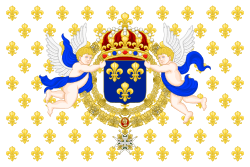
.svg.png)
_crowned.svg.png)
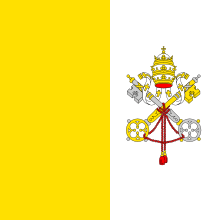
.svg.png)
.svg.png)
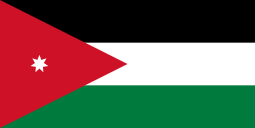


- 1,192nd Knight of the Order of the Golden Fleece[27][34][52][53]
- Knight Grand Cross of the Order of Charles III[27][30][34][54]

National awards


Foreign awards


Arms
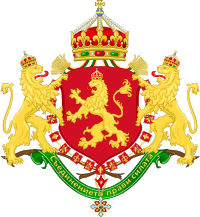 Arms of Simeon II as Sovereign of Bulgaria (1943–1946) |
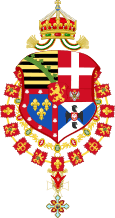 Personal arms of Simeon II |
Patronages
National patronages

Foreign patronages

Ancestry
| Ancestors of Simeon Saxe-Coburg-Gotha |
|---|
See also
- The Boy Who Was a King, a 2011 Bulgarian documentary by Andrey Paounov.
- House of Saxe-Coburg and Gotha
References
- Bulgaria’s Former King and PM Simeon II Celebrates his 80th Birthday - website of the Bulgarian National Television
- "Bulgaria". BBC – Country Profiles. Archived from the original on 7 March 2015. Retrieved 14 April 2015.
- Paskalev, Vesco (2016). "Bulgarian Constitutionalism: Challenges, Reform, Resistance and . . . Frustration". European Public Law. 22: 203–223. Archived from the original on 9 December 2017. Retrieved 8 December 2017.
- Kate Connolly. "Once upon a time in Bulgaria". The Guardian. Archived from the original on 23 July 2015. Retrieved 22 July 2015.
- "Bulgarian Rule Goes to Son, 6. Reports on 5-Day Illness Conflict", United Press dispatch of 28 August 1943, in a cutting from an unknown newspaper in the collection of historian James L. Cabot, Ludington, Michigan
- Theo Aronson, Crowns in Conflict, p.202. London: John Murray (Publishers) Ltd., 1986. ISBN 0-7195-4279-0
- Geoffrey Hindley, The Royal Families of Europe, p. 156. London: Lyric Books Ltd., 1979. ISBN 0-07-093530-0
- "History of King Simeon II". King Simeon. Archived from the original on 3 July 2017. Retrieved 12 May 2017.
- Lilov 2013, p. 89.
- "Simeon Saxe-Coburg-Gotha – Prime Minister of Bulgaria". Archived from the original on 6 May 2006. Retrieved 23 September 2015.
- Lilov 2013, p. 91.
- Lilov 2013, p. 93.
- "The Path to Peace Foundation homepage". Thepathtopeacefoundation.org\accessdate=24 July 2015. Archived from the original on 14 October 2006. Retrieved 27 October 2006.
- "Симеон Сакскобургготски подаде оставка" (in Bulgarian). Труд. 6 July 2009. Archived from the original on 8 July 2009. Retrieved 7 July 2009.
- https://www.researchgate.net/publication/252086513_Will_Bulgaria_Become_Monarchy_Again
- Vassilev, Rossen (2010). "Why Was the Monarchy Not Restored in Post-Communist Bulgaria?". East European Politics and Societies: And Cultures. 24 (4): 503–519. doi:10.1177/0888325409360211.
- "Leader: Bulgaria's Simeon leads by example". 13 July 2001 – via www.theguardian.com.
- "Tsar Simeon: "I am being forced into exile again"". 1 September 2018.
- Un destin singulier. Paris: Flammarion. 29 October 2014. ISBN 9782081314672.
- "Simeon II of Bulgaria presents a preview of his autobiography at UNESCO". UNESCO. 22 October 2014. Archived from the original on 15 August 2015. Retrieved 22 July 2015.
- Simeón II de Bulgaria (1 June 2016). Simeón II de Bulgaria. Ediciones Paraninfo, S.A. ISBN 9788484597285. Archived from the original on 12 August 2016. Retrieved 11 June 2016 – via Google Books.
- Biography: His Majesty King Simeon II of the Bulgarians - official website of H.M. King Simeon II
- The last King of Bulgaria - website of the BBC
- "Letter from Prime Minister Simeon Saxe Coburg Gotha to President Bush (September 13)". Bulgaria-embassy.org. 13 September 2001. Archived from the original on 23 September 2015. Retrieved 22 July 2015.
- "Simeon Saxe-Coburg-Gotha Enthroned by Holy Synod – News – BULGARIAN NEWS AGENCY". Bta.bg. Archived from the original on 18 July 2015. Retrieved 22 July 2015.
- The Grand Master of the Bulgarian Orders - official website of H.M. Simeon II
- Blogspot.com, King Simeon wearing his orders and medal at the Luxembourg Royal wedding Archived 17 February 2015 at the Wayback Machine
- "Editorial & News Images: News Photography, Pictures, Awards, Events, Sports, Celebrity Photos – Getty Images". corbisimages.com.
- Blogspot.com, King Simeon wearing his orders at the Swedish Royal wedding Archived 5 March 2015 at the Wayback Machine
- http://www.kingsimeon.bg/en/ Archived 29 February 2016 at the Wayback Machine, King Simeon wearing his orders in an official photo Archived 5 March 2016 at the Wayback Machine
- "Photographic image" (JPG). Kingsimeon.bg. Archived from the original on 5 March 2016. Retrieved 24 July 2015.
- "Н.В. Цар Симеон II | Великият магистър на българските ордени". Kingsimeon.bg. Archived from the original on 22 December 2010. Retrieved 22 July 2015.
- "Oct 19 – King Simeon II of Bulgaria and Queen Margarita of Bulgaria attend the Gala dinner in Luxembourg. | BULGARIA ( NO REINANTE )". Pinterest. Archived from the original on 23 July 2015. Retrieved 22 July 2015.
- http://www.kingsimeon.bg/en/ Archived 29 February 2016 at the Wayback Machine, page with Simeon's honours Archived 27 January 2016 at the Wayback Machine
- "Speech by King Simeon II at the ceremony of his award of the Stara Planina Order, Ist degree – H.R.H. King Simeon II". Speech by King Simeon II at the ceremony of his award of the Stara Planina Order, Ist degree – H.R.H. King Simeon II. Archived from the original on 5 March 2016. Retrieved 28 February 2016.
- "One World magazine – COUBURGS". Oneworld-bg.net. Archived from the original on 24 February 2015. Retrieved 22 July 2015.
- "Н.В. Цар Симеон II | Новини -> Симеон II получи най-високото отличие на Министерството на правосъдието". Kingsimeon.bg. 26 May 2009. Archived from the original on 23 February 2015. Retrieved 22 July 2015.
- "Queen Anne of Romania and Princess Lilian of Belgium followed by King... News Photo". Getty Images. Archived from the original on 23 July 2015. Retrieved 22 July 2015.
- Noblesse et Royautés Archived 24 October 2012 at the Wayback Machine, Photo Archived 2013-03-17 at the Wayback Machine of Simeon II and Margarita, with the Star of the Knight Grand Cross of the Order of the Belgian Crown.
- "Archived copy". Archived from the original on 5 March 2016. Retrieved 28 February 2016.CS1 maint: archived copy as title (link)
- "Photographic image" (JPG). 1.bp.blogspot.com. Archived from the original on 5 March 2015. Retrieved 24 July 2015.
- "Photographic image" (JPG). Tb.ziareromania.ro. Archived from the original on 17 February 2015. Retrieved 24 July 2015.
- "radical royalist: 25 years ago Empress Zita of Austria passed away". Radicalroyalist.blogspot.co.uk. 14 March 2014. Archived from the original on 7 November 2017. Retrieved 22 July 2015.
- "The Royal family attended the reception on the occasion of the Day of St. John the Baptist, patron of the Order of Malta – H.R.H. King Simeon II". The Royal family attended the reception on the occasion of the Day of St. John the Baptist, patron of the Order of Malta – H.R.H. King Simeon II. Archived from the original on 5 March 2016. Retrieved 28 February 2016.
- "Archived copy". Archived from the original on 5 March 2016. Retrieved 28 February 2016.CS1 maint: archived copy as title (link)
- "The Majesties attended the celebrations of the 900th anniversary of the Sovereign Order of Malta – H.R.H. King Simeon II". The Majesties attended the celebrations of the 900th anniversary of the Sovereign Order of Malta – H.R.H. King Simeon II. Archived from the original on 5 March 2016. Retrieved 28 February 2016.
- "MEMBERSHIP OF THE ROYAL ILLUSTRIUOS ORDER OF ST. JANUARIUS". g/ The Royal House of the Two Sicilies. 2008. Archived from the original on 9 January 2009. Retrieved 26 October 2008.
- "Membership of the Constantinian Order". g/ Sacred Military Constantinian Order of Saint George. 2008. Archived from the original on 5 March 2012. Retrieved 13 October 2008.
- "SAINTANNA.RU – Кавалеры 1-й степени". saintanna.ru. Archived from the original on 28 March 2012.
- "SAINTANNA.RU – List of recipients". saintanna.ru. Archived from the original on 23 April 2012.
- "Prince Leka of Albania". Archived from the original on 22 April 2016. Retrieved 8 April 2016.
- "BOE 238 de 02/10/2004 Sec 3 Pag 33224 a. 33224" (PDF). Boletin Oficial Del Estado. 2 October 2004. Archived (PDF) from the original on 24 September 2015. Retrieved 23 September 2015.
- "King Simeon II of Bulgaria Photos – Zimbio". M.zimbio.com. Archived from the original on 17 February 2015. Retrieved 22 July 2015.
- "7 julio 1955 B. O. del E—Núm. 188" (PDF). 28 May 2009. p. 4084. Archived (PDF) from the original on 24 September 2015. Retrieved 23 September 2015.
- "Н.В. Цар Симеон II | Новини -> Н.В. Цар Симеон ІІ получи медал и грамота в чест на 125-ата годишнина на 9-и пехотен полк на Княгиня Клементина". Kingsimeon.bg. Archived from the original on 23 February 2015. Retrieved 22 July 2015.
- "Н.В. Цар Симеон II | Новини -> Негово Величество получи почетния знак на българските читалища". Kingsimeon.bg. Archived from the original on 23 February 2015. Retrieved 22 July 2015.
- "Н.В. Цар Симеон II | Новини -> Н. В. Цар Симеон ІІ бе удостоен с наградата на Паневропейския съюз за големия му принос за европейската интеграция на България". Kingsimeon.bg. 18 November 2010. Archived from the original on 10 January 2011. Retrieved 22 July 2015.
- "Н.В. Цар Симеон II | Новини -> Под заглавие "Ексклузивно от Букурещ – Симеон II посрещнат с почести" списание Hello публикува три страници за посещението на Техни Величества в румънската столица". Kingsimeon.bg. 16 December 2012. Archived from the original on 23 February 2015. Retrieved 22 July 2015.
- "Н.В. Цар Симеон II | Новини -> Царят е патрон на Деня на България в Загреб". Kingsimeon.bg. 24 May 2010. Archived from the original on 23 February 2015. Retrieved 22 July 2015.
- Sobola, Marek (2017). Príbeh svätojánsky, Socha sv. Jána Nepomuckého v Divine / The Story of St. John, Statue of St. John of Nepomuk in Divina / ដំណើររឿងរបស់ St. John, រូបចម្លាក់ St. John Nepomuk នៅក្រុង Divina / Die Johannisgeschichte, Die Staute des hl. Johannes Nepomuk in Divina / Историята на св. Ян, Статуята на св. Ян Непомуцки в Дивина. Slovakia: Servare et Manere, o. z. & Kysucké múzeum v Čadci. pp. 77–79. ISBN 978-80-972614-3-6.
- "Biskup Galis požehnal obnovenú sochu sv. Jána Nepomuckého v Divine". tkkbs.sk. Archived from the original on 2 July 2017. Retrieved 29 July 2017.
Bibliography
- Ramon Perez-Maura, El rey possible: Simeon de Bulgaria, Belacqua, Madrid, 2002 (ISBN 8495894238)
- Simeon II de Bulgarie, Sébastien de Courtois, Un destin singulier, Flammarion, 2014 (ISBN 9782081314672)
Books
In addition to the books listed in the References, the following may be mentioned:
- Walter J.R. Curley, Monarchs in Waiting. London: Hutchinson & Co., 1975. (pp. 23–25: "Bulgaria: His Majesty King Simeon II")
- Pashanko Dimitroff, Boris III of Bulgaria 1894–1943. London, 1986. ISBN 0-86332-140-2
- Charles Fenyvesi, Royalty in Exile. London: Robson Books, 1981. (pp. 153–171: "Czar Simeon of the Bulgars") ISBN 0-86051-131-6
- Stephane Groueff Crown of Thorns, Lanham MD. and London, 1987. ISBN 0-8191-5778-3
- Gregory Lauder-Frost, The Betrayal of Bulgaria, Monarchist League Policy Paper, London, 1989.
- Robert K. Massie and Jeffrey Firestone, The Last Courts of Europe. New York: Greenwich House, 1983. ISBN 0-517-41472-4
- Lilov, Grigor (2013). Най-богатите българи (1st ed.). Sofia: "Кайлас" ЕООД. ISBN 978-954-92098-9-1.CS1 maint: ref=harv (link)
Articles
- The Daily Telegraph, Obituary for "HM Queen Ioanna of the Bulgarians", London, 28 February 2000.
External links
| Wikimedia Commons has media related to Simeon II of Bulgaria. |
- King Simeon II – Personal website
- The first website about Simeon II of Bulgaria focuses on his pre-1995 history
- Saxe-Coburg-Gotha's statement, 5 July 2002 concerning Bulgaria's candidacy for NATO membership: "The role of the international community should be gradually transformed from crisis response to integration. Palliative measures intended to mitigate yet another crisis cannot bring stability and prosperity. The best solution is the region's integration into the European and Euroatlantic institutions."
- Saxe-Coburg-Gotha's address, 10 February 2005 concerning amending the constitution to bring it in line with EU requirements, Standart
Simeon Saxe-Coburg-Gotha Cadet branch of the House of Wettin Born: 16 June 1937 | ||
| Regnal titles | ||
|---|---|---|
| Preceded by Boris III |
Tsar of Bulgaria 1943–1946 |
Vacant |
| Political offices | ||
| Preceded by Ivan Kostov |
Prime Minister of Bulgaria 2001–2005 |
Succeeded by Sergei Stanishev |
| Preceded by Prince Alexander Ernst |
Line of succession to the former Saxe-Coburg and Gotha throne 9th position |
Succeeded by Prince Boris |
.svg.png)